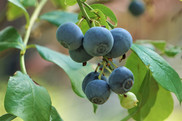
New Ornamental Blueberries Were Bred for Home Landscapes
For years, University of Georgia plant breeder Scott NeSmith has created blueberry varieties for the commercial market. Now, he’s introduced a series of blueberry plants bred for home gardeners.
Commercial blueberry varieties must also ripen at one time. In a home setting, gardeners like to pick a bowlful at a time, so they don’t mind an extended ripening season, NeSmith said. Many of the blueberry plants bred by NeSmith did not meet commercial standards but produced pretty and large fruit or a plant with an attractive shape or foliage. He decided to take a second look at these plants for home gardeners and the edible-ornamental market.
Representatives from the nursery industry also approached him and requested material specifically for home landscapes. They collaborated with UGA to provide NeSmith with input and to test the edible-ornamental selections. “We wanted these plants to produce good-tasting fruit,” he said. “Some produce small, dark berries, and some produce multicolored berries. Above all, you don’t have to worry about whether your kids or grandkids pick and eat them because they are safe to eat.”
The following are a few of the blueberry varieties NeSmith has released especially for home gardens.
Blue Suede™ is a highbush blueberry that produces a normal-sized home garden plant, has attractive, sky-blue fruit and attractive fall foliage, ripens over time, and is self-pollinating.
Cutie Pie™ is a dwarf hybrid that’s compact, with small leaves, generally keeps attractive foliage into the fall, is very attractive during flowering because it puts on a lot of flowers, has small, darker berries, and produces a good crop load.
Frostberry Delight™ is a rabbiteye blueberry that produces large, sky-blue berries and blue, green and silver foliage, is self-pollinating, and is heat- and drought-tolerant.
Southern Bluebelle™ is a highbush blueberry that’s an ultra-dwarf plant, produces medium- to large-sized, light-blue fruit and an abundance of berries, and flowers profusely.
Summer Sunset® is a rabbiteye blueberry that has deep green foliage, multicolored berries that turn from light green to yellow to orange to sunset red to midnight blue as they ripen, and produces normal-sized berries with a full-flavored taste.
Read the full story at UGA Extension.
Contact: Sharon Dowdy, UGA Extension.
|